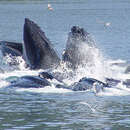Diagnostic Description
provided by FAO species catalogs
The humpback whale differs substantially from the general rorqual body plan. The body is more robust; the flippers are extremely long (up to one-third of the body length) with a series of bumps, including 2 more prominent ones in consistent positions on the leading edge, more-or-less dividing the margin into thirds. The flukes have a concave, serrated trailing edge, and the dorsal fin is low and broadbased (usually sitting on a hump). The head has a single median ridge, and the anterior portion of the head is covered with many bumps (each containing a single sensory hair). The body is black or dark grey dorsally and may be white ventrally, but the borderline between dark and light is highly variable and seems to differ by population (the white extends up onto the sides and back in some Southern Hemisphere humpbacks). The flippers are white on the ventral side and vary from all-white to mostly black on the dorsal surface. The ventral side of the flukes also varies from all-black to all-white. There are 270 to 400 black to olive baleen plates, and 14 to 35 ventral pleats extending back to the navel or beyond. The blow is rather low and bushy for a balaenopterid, reaching only 3 m. It may sometimes appear V-shaped. Can be confused with: At close range, the humpback is one of the easiest whales to identify. At a distance, however, there can be some confusion with other large whales, especially blue whale and sperm whale. When a closer look is obtained, humpbacks are generally unmistakable.
- bibliographic citation
- Marine mammals of the world. Jefferson, T.A., S. Leatherwood & M.A. Webber - 1993. FAO species identification guide. Rome, FAO. 320 p. 587 figs. .
- author
- Food and Agriculture Organization of the UN
Size
provided by FAO species catalogs
Adult humpback whales are 11 to 16 m long and newborns are 4.5 to 5 m in length. Weights of at least 35 t are attained by adults.
- bibliographic citation
- Marine mammals of the world. Jefferson, T.A., S. Leatherwood & M.A. Webber - 1993. FAO species identification guide. Rome, FAO. 320 p. 587 figs. .
- author
- Food and Agriculture Organization of the UN
Brief Summary
provided by FAO species catalogs
Although they generally occur singly or in groups of 2 or 3, larger aggregations develop in feeding and breeding areas. Humpbacks are probably the most acrobatic of all great whales, sometimes performing full breaches that bring their entire bulk out of the water.They are adaptable lunge feeders, which use bubble nets, bubble clouds, tail flicks, and other techniques to help concentrate krill and small schooling fish for easier feeding. Sometimes humpbacks gather into coordinated groups of up to 20 or more whales, which work together to herd and capture prey. On the breeding grounds, males appear to compete for access to estrus females, apparently using their now well-known complex songs as part of their breeding display. Calves are born on wintering grounds in tropical and subtropical regions. Individual humpback whales can be identified using photographs of the distinctive markings on the undersides of their flukes. Such photos can be of great help in defining movements and migrations of this and other species.
- bibliographic citation
- Marine mammals of the world. Jefferson, T.A., S. Leatherwood & M.A. Webber - 1993. FAO species identification guide. Rome, FAO. 320 p. 587 figs. .
- author
- Food and Agriculture Organization of the UN
Benefits
provided by FAO species catalogs
Humpback whales were not a favorite target of Yankee whalers. However, because of their relatively slow swimming speeds and coastal habits, they were an early target of modern large-scale commercial whaling, beginning with shore based whaling in many areas. Since international protection in 1944, most stocks now appear to be stable or on the rise. IUCN: Vulnerable.
- bibliographic citation
- Marine mammals of the world. Jefferson, T.A., S. Leatherwood & M.A. Webber - 1993. FAO species identification guide. Rome, FAO. 320 p. 587 figs. .
- author
- Food and Agriculture Organization of the UN

